



The signs are set up in the vicinity of the location or at the beginning of the stretch of road the content of the sign refers to. Signs that are set up at some distance, may be provided with the distance specification at the bottom of the sign or on the plate below the sign.
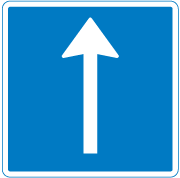
The signs indicate the traffic direction in the junction, for which the lane under a sign is intended.
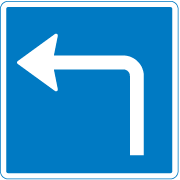
The signs indicate the traffic direction in the junction, for which the lane under a sign is intended.
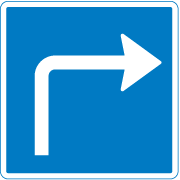
The signs indicate the traffic direction in the junction, for which the lane under a sign is intended.
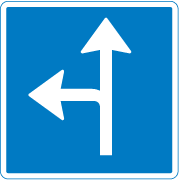
The signs indicate the traffic direction in the junction, for which the lane under a sign is intended.
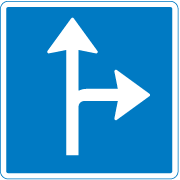
The signs indicate the traffic direction in the junction, for which the lane under a sign is intended.
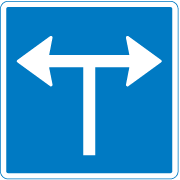
The signs indicate the traffic direction in the junction, for which the lane under a sign is intended.
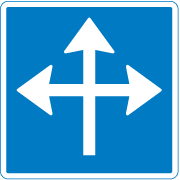
The signs indicate the traffic direction in the junction, for which the lane under a sign is intended.
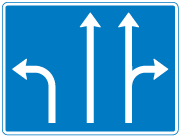
The sign indicates the traffic directions in the junction, for which the individual lanes are intended. The sign can display marking of the lane, verges and similar.
If a traffic sign is provided with an arrow, the sign for the relevant lane applies. For roadworks, signs and possible plates below the signs can be made with black symbols on a yellow background.
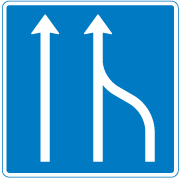
The sign indicates the flow of the lane and traffic direction. Verges, obstacles and similar can be displayed on the sign, just as lanes from the opposite traffic direction can be indicated. With the reduction of the number of lanes, the driver must demonstrate mutual consideration, see the Road Traffic Act, Section 18, item 4.
If a traffic sign is provided with an arrow, the sign for the relevant lane applies. For roadworks, signs and possible plates below the signs can be made with black symbols on a yellow background.
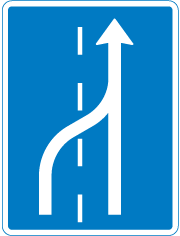
The sign indicates the flow of the lane and traffic direction. Verges, obstacles and similar can be displayed on the sign, just as lanes from the opposite traffic direction can be indicated. With the reduction of the number of lanes, the driver who changes lane must ensure that this can be done without danger or unnecessary inconvenience to others, see the Road Traffic Act, Section 18, item 2.
If a traffic sign is provided with an arrow, the sign for the relevant lane applies. For roadworks, signs and possible plates below the signs can be made with black symbols on a yellow background.
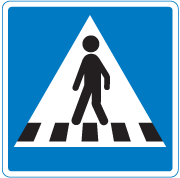
Pedestrian crossing.
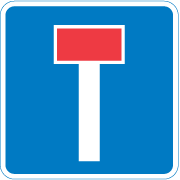
With a thin white line, it can be indicated that the road continues into a path.

One-way traffic.
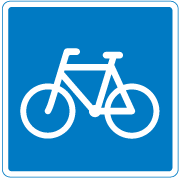
On routes marked with E 21.1, driving with a small moped can be prohibited on certain partial stretches. The sign indicates roads, paths or similar that can be appropriately used by the types of traffic that are indicated with a symbol.
See also route directions for path users, F 21 path directions for cyclists, horse riders and hikers, see Section 30.
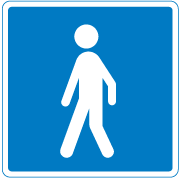
Recommended route for hikers. The sign indicates roads, paths or similar that can be appropriately used by the types of traffic that are indicated with a symbol.
See also route directions for path users, F 21 path directions for cyclists, horse riders and hikers, see Section 30.
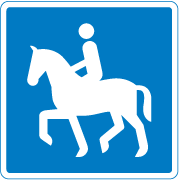
Recommended route for horse riders. The sign indicates roads, paths or similar that can be appropriately used by the types of traffic that are indicated with a symbol.
See also route directions for path users, F 21 path directions for cyclists, horse riders and hikers, see Section 30.
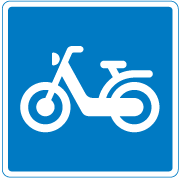
Recommended route for small moped. The sign indicates roads, paths or similar that can be appropriately used by the types of traffic that are indicated with a symbol.
See also route directions for path users, F 21 path directions for cyclists, horse riders and hikers, see Section 30.
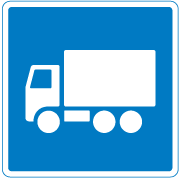
Recommended route for lorries.
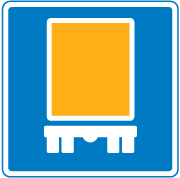
Recommended route for vehicles with hazardous goods.

Recommended route for bus.
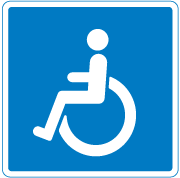
Guide for disabled. A symbol can be applied to the sign for ramps and, on the plate below the sign, the gradient of the ramp. For a parking bay, the plate below the sign can indicate that the reservation applies to one or more specific vehicles, see the Road Traffic Act, Section 92, item 3.
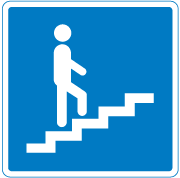
Pedestrian tunnel or pedestrian bridge.
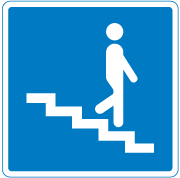
Pedestrian tunnel or pedestrian bridge.

The sign indicates where buses are allowed to stop and where the regulations in the Road Traffic Act, Section 29, item 2, on the bus stop apply. The area may only be used by buses during ordinary route driving.

Taxi rank.
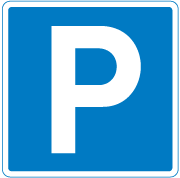
The sign indicates the area intended for parking. On the zone sign, the E 33 sign is only used to indicate the limitations to the access to park in the area. The chevron shaped roof symbol above the symbol indicates that it concerns indoor parking. Direction and/or distance to the parking space and limitations or relaxation in the access to park can be indicated either on the sign itself or the plate below the sign.
Regarding parking in bays, see Section 56, T 33 Parking bay.
If the parking area is on the roadway without being demarcated on the roadway, the stretch of the parking area on the roadway is indicated with the plates UE 31.1 - 33.4 below the sign. Furthermore, the regulation on parking as stated in Section 17 regarding C61-62, UC 33 and UC 61-62 applies in the same way.
Where E 33 is supplemented with the plate E 23 Guide for disabled below the sign, it must indicate that the parking area may only be used for stopping and parking of vehicles that are provided with the issued permit according to Section 88 a of the Road Traffic Act.
In areas where a general parking limitation for certain vehicles exists, this parking limitation can be discontinued locally by supplementing E 33 with plate below the sign that displays the symbol for the actual vehicles with »Permitted« under the symbols.
With a black plate below the sign, reference can be made to the rules for privately managed parking schemes.
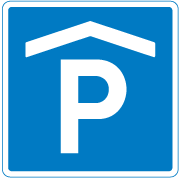
The sign indicates the area intended for parking. On the zone sign, the E 33 sign is only used to indicate the limitations to the access to park in the area. The chevron shaped roof symbol above the symbol indicates that it concerns indoor parking. Direction and/or distance to the parking space and limitations or relaxation in the access to park can be indicated either on the sign itself or the plate below the sign.
Regarding parking in bays, see Section 56, T 33 Parking bay.
If the parking area is on the roadway without being demarcated on the roadway, the stretch of the parking area on the roadway is indicated with the plates UE 31.1 - 33.4 below the sign. Furthermore, the regulation on parking as stated in Section 17 regarding C61-62, UC 33 and UC 61-62 applies in the same way.
Where E 33 is supplemented with the plate E 23 Guide for disabled below the sign, it must indicate that the parking area may only be used for stopping and parking of vehicles that are provided with the issued permit according to Section 88 a of the Road Traffic Act.
In areas where a general parking limitation for certain vehicles exists, this parking limitation can be discontinued locally by supplementing E 33 with plate below the sign that displays the symbol for the actual vehicles with »Permitted« under the symbols.
With a black plate below the sign, reference can be made to the rules for privately managed parking schemes.
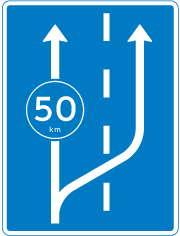
The sign indicates special lanes that must be used by vehicles that drive at a lower speed than what is indicated for the other lanes, see the Road Traffic Act, Section 14, item 5 for more detail.
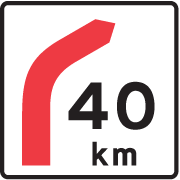
The sign indicates the speed at which the bend on an exit road can be driven through under normal conditions.
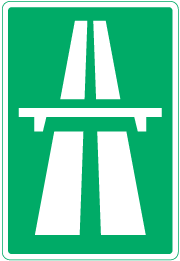
The sign indicates the stretch of road where the special rules on driving on a motorway and approach/exit roads to/from a motorway apply, see the Road Traffic Act, Sections 44-47.
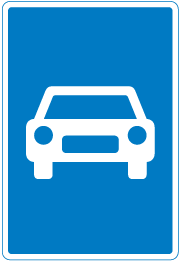
The sign indicates the stretch of road where the special rules on driving on a carriageway and approach/exit roads to/from a carriageway apply, see the Road Traffic Act, Section 48.
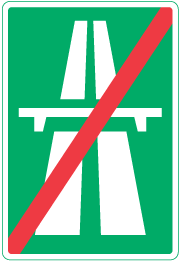
The sign is not normally used at the joining of the exit roads to the ordinary road network.
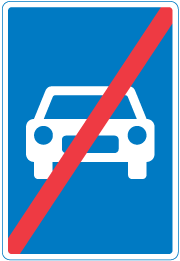
The sign is not normally used on roads that cross a carriageway or at the joining of the exit roads to the ordinary road network.
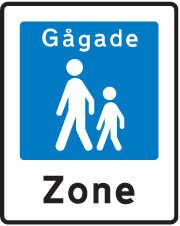
The sign indicates an area in which the following special traffic rules apply:
1) The area is reserved for pedestrians.
2) Permission for driving in the area can be given. In such case, driving must occur while observing the regulations under points 4-8.
3) Any permit for driving is indicated on the plate below the sign as stated in Section 16, item 3, points 2-5. In addition, the plate »Driving permitted« under the sign or other plates that allow driving with specific types of traffic can be used. Permission indicated on the plate below the sign can be limited in terms of time, see Section 9, sign U 3.
4) Driving in the area may only occur with very low speed (normally below 15 km/h).
5) The driver must demonstrate special awareness and consideration of pedestrians, see the Road Traffic Act, Section 27, item 3.
6) When people are on the road who may become dangerously close to the vehicle while it passes, the driving may not continue before the driver has made sure that these people are aware of the vehicle and have made room for passing. However, such people may not unnecessarily prevent the vehicle from moving on.
7) Parking in a pedestrian street may not occur outside of specially demarcated bays. This does not, however, apply to bicycles, mopeds and motorcycles.
8) Vehicles have absolute duty to give way when exiting a pedestrian street, see the Road Traffic Act, Section 26, item 3.
The sign can be used with the plates U 1, U 2 or U 6 below the sign as advanced warning.
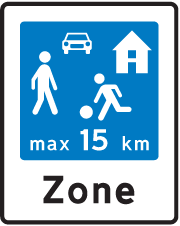
Open area and play area.
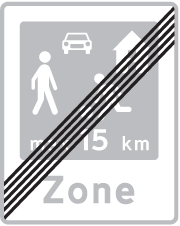
End of open area and play area.
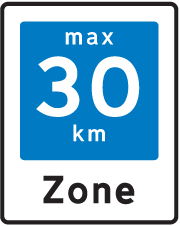
The sign indicates an area where the roadway is laid out so that it is not suitable for driving with higher speeds than what is indicated.
The sign can be used with the plates U 1, U 2 or U 6 below the sign as advanced warning.
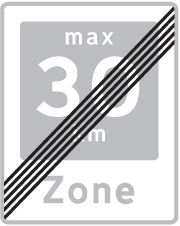
End of speed reduction area.

The sign indicates the area where the Road Traffic Act’s rules for a densely built-up area apply. The geographic town name of the area can be specified in Danish as well as in English or a neighbouring country’s official language. The sign can be made as a plate and can be set up as a plate below the sign, C 56 End of local speed limit.

The geographic name of the area can be specified in Danish as well as in English or a neighbouring country’s official language.
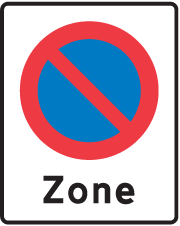
The sign indicates an area in which the regulations for the signs that are specified as symbols are applicable, see however E 33 Parking. The more detailed content of the regulations and the distance to the start of the area can be indicated on the sign.
The regulations apply until they are discontinued with sign E 69 or until they are replaced by specification regarding the same conditions on another zone sign. Within the area, the regulations of the zone sign can be deviated from with local demarcation.
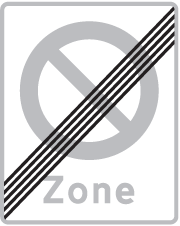
End of zone
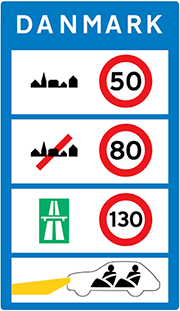
The sign indicates the general speed limits that apply in the country.